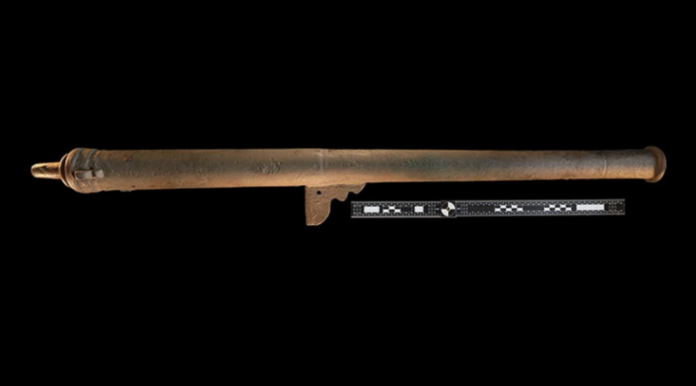If you think the old Winchester model 1894 your great-grandfather left you in his will is an old gun, it might be time to rethink that assessment.
Researchers in Arizona believe they have found the oldest gun ever discovered in the continental United States—a nearly 500-year-old cannon recently unearthed in the southern part of the state. According to a study published in the International Journal of Historical Archaeology, the bronze cannon, likely associated with the first European expedition through the Southwest, was discovered in 2020 on the floor of a stone and adobe building near the Santa Cruz River.
Archaeologists dated the cannon using carbon dating technology and determined it was 480 years old. It likely sat inside the ruin since 1540, when the first European settlement, San Geronimo III, was established.
Researchers report that the gun had never been fired, and they believe it was left behind when indigenous natives of the area attacked the settlement.
“The gun is an important artifact, and is no doubt the earliest known surviving firearm in the United States and one of, if not the earliest found in a reliable context in the New World,” the researchers wrote.
Wall guns like the one discovered were designed to be mounted on wooden tripods along fortification walls. Because they were lightweight and durable, such guns were perfect for long exploration expeditions.
The cast-iron weapons could fire either loads of buckshot or large lead balls. Since the one discovered in Arizona had no sights, researchers believe it was probably intended to fire buckshot.
Coronado set off on the expedition in early 1540, followed later by the main body of the expedition, which included around 2,800 people and thousands of head of livestock. According to the report, the expedition wasn’t considered successful since it didn’t find the riches and treasures the explorers sought on their journey.
The archaeological site also yielded several other prizes for researchers, including arrowheads, lead bullets and weapons parts. They believe that after the Spanish fled the attack by the Sobaipuri O’odham people in the 1540s, they didn’t return to explore the Southwest until the late 1600s.
“Europeans did not return to what became southern Arizona for another 150 years, making it the earliest and most consequential Native American uprising in the continental U.S.,” the researchers said. “This fact is surprising given that until this discovery the O’odham were thought to have played at most an insignificant role in the initial conquest episode.”





I am having a hard time calling this object a “gun” when it is clearly a cannon.
Outside of that, it is a fascinating find.
A cannon is a large caliber gun with a different area classification, differentiated from person born firearms, of usually ‘artillery’
This was just 42″ long and only weighed 40lbs even though it was a bronze casting. I’ve yet to find anything online that states what caliber it was but it couldn’t be much more than .50 and likely less than a 12″ shotgun I would guess or it would have weighed much more being brass. That’s pretty small and hardly a cannon by any means I would say.
???
it wasn’t a caliber in the traditional person born firearm sense of rifles and pistols. ‘caliber’ for today’s use of the word, it was more like ‘bore’ size in terms of capacity it could hold for the size of ‘shot’ used. man portable small canon back then like this were more like big shotguns being used. The ‘Canon’ would be loaded with powder and barrel loaded up with some pre-determined ‘standard load of shot’ and fired at a close range soft targets.
Smallish punt gun, basically…
.87″ bore, ~7 ga.
Biggest shoulder-fired BP gun I have heard of was a 4 ga (African) elephant rifle.
Baker-White used a rifle that fired a 6 oz bullet for (Indian) elephant in Ceylon. IIRC, doesn’t mention gauge. Coincidentally weighed about 40 lb – per “Rifle and Hound”.
The gunbearer was a necessity, and the risk of permanent injury from recoil real.
Very cool find! The Spanish emphasis on treasure is remarkably dumb. Then again 500 years doesn’t translate well to 2024 🙄
So it was just laying on the floor of an abandoned building for the last 500 years?
Clearly a destructive device without a tax stamp, it was being hidden from the BATF.
Did it have a switch or a supressor.
“gun had never been fired”? Sounds unlikely. Given the poor quality of casting tech in the 1500s, it is unlikely would not have test fired/proofed a new gun.
or… placed there by the ATF to entrap some archeologist.
😅
Well, you figured out their diabolical plan..
but it does sound like something the atf would do though.
🤣
Yep. Supposedly a couple more of the abandoned bronze boomers from that expedition somewhere.
jwm,
I saw a photo somewhere else which appeared as though that cannon was buried under a dirt floor of some structure.
Now I gotta take a pick and shovel next time I visit Arizona. 🙂
From what I remember the Coronado Expedition wasn’t a success because all but about a dozen of them frickin died.
Had they found gold that would not have mattered. As long as one made it home to tell the tale.
As a kid in the 1980s I found a chain mail glove that was dated to the same era and it has been in several museums over the years. I also found a button and a silver coin in the same area.
OK, the example has been given.There should be a cannon in every american home. And yes, I’m serious.
And every american mathematics class, staring in Jr High school and beyond, should include the understanding and mathematical calculations of indirect artillery fire.
OK. Done.
First it says bronze, then later says cast iron. So which is it?
The Black Swallow Of Death – Eugene Bullard.
https://www.youtube.com/watch?v=NJ7n-uYSVkA
The Black Swallow Of Death – Eugene Bullard.
h ttps://www.youtube.com/watch?v=NJ7n-uYSVkA
it wasn’t a caliber in the traditional person born firearm sense of rifles and pistols. ‘caliber’ for today’s use of the word, it was more like ‘bore’ size in terms of capacity it could hold for the size of ‘shot’ used. man portable small canon back then like this were more like big shotguns being used. The ‘Canon’ would be loaded with powder and barrel loaded up with some pre-determined ‘standard load of shot’ and fired at a close range soft targets.
I’ll trade you this thunder stick for two squaws and that bucket of yellow rocks.
” ehhhh, throw in a horse and 5 pigs and you’ve got yourself a deal.”
[Later that day]
“WTF we forgot to get the smoke boom powder, thunder stick no good. White man fcked us again. ”
Pa, anothern of them pigs gots the fever.
” Saddle up the horse and go fetch the vet.”
Pa what’s a saddle?
“Damn them white eyes did it again.”
Pa, what’s for dinner?
” It sure as hell ain’t buffalo, and get them blankets away from Running Deeraria, seems like everybody that gets close to them gets sick.”
At no point in time did this firearm ever commit a mass shooting. This proves it is the person who commits gun violence not the firearm.
I’m watching for a 10 ft. sword inscribed in Philistine with “Property of Goliath of Gath: Keepa you hands off!” To show up on the Antiques Road Show.
Minor terminology gripe: this gun couldn’t have been designed to fire “buckshot”, because the neither the word nor the type of ammunition existed when it was made. I’d guess it was designed to fire canister rounds, the direct ancestor of buckshot.
Actually, they understood the concept and used buckshot just fine. General George Washington was famous, or perhaps infamous, for frequently ordering his troops to load buck and ball in their muzzle loading muskets. The wadding sufficed as a cannister.
lead or iron ball ‘shot’ (i.e. basically large buckshot, ranging from 0.5 inches to 1.5 inches in diameter) for canon was well known and used back then, and had been for canon since the 12th century.
What Bore diameter was this shotgun?
Is it bronze, or cast iron? The article has it both ways.
OK, from the picture it’s clearly bronze, but c’mon. A little proof-reading would be nice.
Comments are closed.